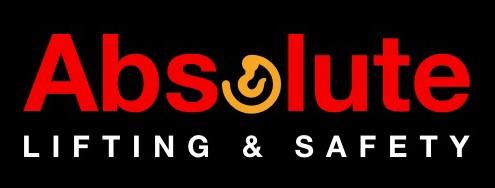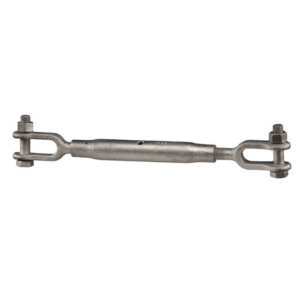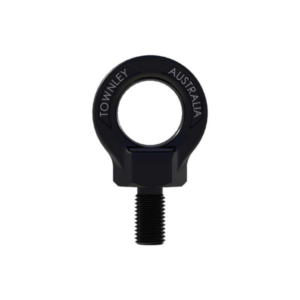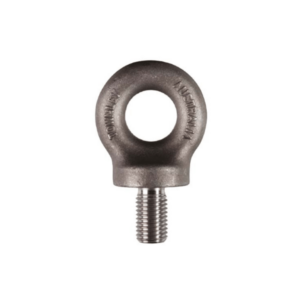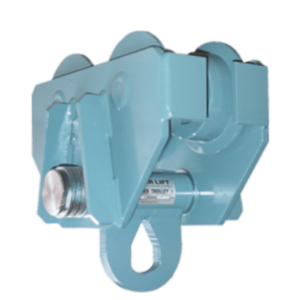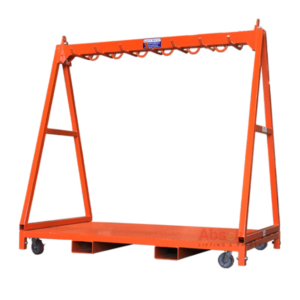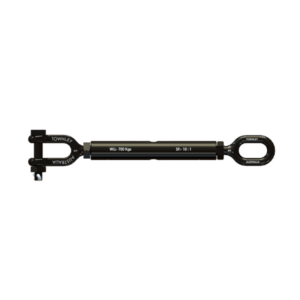Care Use & Inspection of Eyebolts
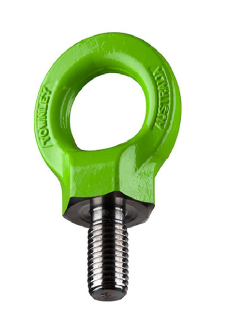
Care, Use & Inspection of Eyebolts
The care, use and inspection of eyebolts is especially necessary when in service eyebolts are transferred from job to job. Eyebolts should be carefully examined periodically by a competent person. Should the eye or shank show any excessive wear or damage, then the eyebolt should be discarded and removed from service.https://italcultur.com/sesso-in-macchina-regole-e-sicurezza/
Guidelines for general use
IS THE EYEBOLT TIGHT?
Do not excessively tighten, but have less than
0.04mm gap between the collar and the face of
the load.
HAS THE WORKING LOAD LIMIT BEEN CHECKED?
Make sure the W.L.L for the eyebolt is checked
against the load being lifted.
DO THE THREADS MATCH?
The threads of the eyebolt and hole must match in
both size and thread type
HAS THE EYEBOLT BEEN INSPECTED PRIOR TO USE?
Check the eyebolt for cracks, corrosion,
deformation or thread damage and debris.
Discard if worn.
USE EYEBOLTS WHICH CONFORM TO AUSTRALIAN STANDARDS
The Australian Standard for Collard Eyebolts is AS 2317.1:2018
Eyebolt Inspection Prior to Use
How to identify an eyebolt conforms to Australian Standards?
- Manufacturer’s Identification.
- ‘M’ to denote ISO metric thread, coarse series; ‘B’ for BSW; or ‘U’ for UNC.
- Nominal size, e.g. M16.
- The Working Load Limit marking must be present.
Legible Markings
Ensure the WLL is clearly legible.
Threads
Threads should be concentric and fit neatly into a standard nut.
Threaded hole
The threaded hole in which the eyebolt is to be fitted should also be carefully checked to ensure the hole is free from dirt, grease and other contaminants. This could restrict the eyebolts from seating correctly in the hole. Particular attention should be paid to the hole thread to ensure it is in good condition.
Check that the hole thread and the eyebolt thread are compatible.
Signs of Deformation
Cracking , nicks, gouges and excessive bruising, wear or corrosion.
Centre Line
Check that the centre line of the eye is aligned with the centre line of the thread.
Check the surface area
It is important to also carefully check the surface area around the threaded hole (which the eyebolt collar will sit on) to ensure it is clean, free from deformation, cracking or any other problem that may restrict the eyebolt seating correctly.
Care and Use of Eyebolts
Small Eyebolts
Normally, eyebolts of sizes smaller than 12mm should not be used for general lifting, staying or tensioning purposes, as high torsional stresses are easily induced in these smaller sizes by being screwed up too tightly. However, where they are used, care should be taken to not cause excessive torsional stresses while they are being fitted to a threaded hole.
Matching of Threads
Extreme care should be taken to ensure that eyebolts are not screwed into threaded holes of a different size or type of thread. Accidents may be caused by eyebolts with metric threads being screwed inadvertently into tapped holes having a BSW or UNC thread and vice versa. Apart from force fits, the thread sizes listed in the table below may be wrongly matched with the risk that the eyebolt may pull out of the threaded hole below the design load. The possibility of mixing threads has always existed, but it has been accentuated by the change to metric threads. Where an eyebolt is removed from a threaded hole, it is recommended that the surface adjacent to the threaded hole be marked with the thread type and size and a plug be inserted into the threaded hole, or that other equally effective action is taken to reduce the possibility of mismatching threads. Where an eyebolt cannot be screwed by hand, the cause of the tight fit may be mixed threads.
Threaded Attachment
Where an eyebolt is used in an untapped hole, the thread should engage a nut with a thread length of at least the full thickness of a standard sized nut. Where an eyebolt is used with a tapped hole in a plate the length of thread engagement should be at least the nominal diameter of the thread. Where the undercut is not sufficient to allow for an adequate engagement of the collar, a parallel washer beneath the collar should be used so that an adequate engagement is achieved If the nut side of the eyebolt is on a tapered surface, such as the inside flange of an RSJ beam, then a tapered washer should be used.
Use with a Single Eyebolt
Where a single eyebolt is used care should be taken to ensure that it remains screwed home throughout the lifting operation. If a single eyebolt is used for lifting and there is a possibility that the load will rotate or twist, a swivel should be used in the system to prevent the eyebolt unscrewing
Tightening of eyebolts
Eyebolts should be screwed fully down to the face of the lifted load; however, excessive tightening of the eyebolt should be avoided. It should not be possible to enter a 0.04 mm feeler gauge at any position between the collar of an eyebolt and its seating. Where this condition is not achieved, any non-axial loading may overstress the screw thread.
Alignment of eye
Where correct alignment of the eye of an eyebolt is required but not accomplished at the first fitting, it should be achieved by the following methods: a) Fitting a shim washer of steel under the collar. A shim washer should not be less in diameter than the diameter of the collar, and the thickness should be between 50% and 100% of the pitch of the threaded shank. b) Machining the underside of the collar. The amount of material machined from the collar should not exceed 50% of the pitch of the thread on the shank of the eyebolts.
Loading Not Aligned with Threaded End
Where the centre-line of loading is not in line with the axis of the threaded end of the eyebolt, including where a two-leg sling is connected to a pair of eyebolts to support a load, the following apply: (a) The diameter of the boss of the tapped hole, into which the eyebolt is screwed, should be no less than the diameter of the collar of the eyebolt. (b) The angle between the centre-line of the loading on the eye of the eyebolt and the plane containing the eye of the eyebolt should not exceed 5°, unless an adequate reduction is made to the WLL. Where the perpendicular loading is applied (sometimes called ‘trunnion lifting’), the eye of the eyebolt should be aligned in the vertical plane. Where two pairs of eyebolts are fitted to a single item, lifting should be effected by means of two two-leg slings and a spreader bar to ensure the load is distributed evenly across the eyebolts. This arrangement also allows the load to be readily applied to each eyebolt in the plane of the eye. Use with a Single Eyebolt Where a single eyebolt is used care should be taken to ensure that it remains screwed home throughout the lifting operation. If a single eyebolt is used for lifting and there is a possibility that the load will rotate or twist, a swivel should be used in the system to prevent the eyebolt unscrewing.
Attachment of slings
Eyebolts are not designed to have hooks attached directly to them. An approved shackle should always be fitted to the eyebolt and the slings are then attached to the shackWorking Load Limits On Pairs of Eyebolts
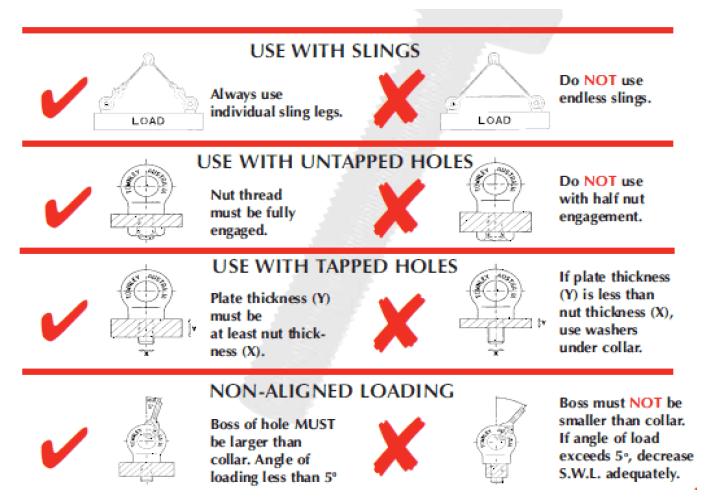
Working Load Limits On Pairs of Eyebolts
The Working Load Limits specified in the Australian Standard applies to a direct vertical loading. Where eyebolts are used in pairs and the lift is taken by means of two-legged slings, allowance must be made for the angle between the sling legs, and the Working Load Limit decreased accordingly. The table on the following page indicates Working Load Limit of two-legged slings with included angles of 30°, 60° and 90°, with the
comparative value when the load is carried through a single eyebolt. The load applied to eyebolts, when used in pairs and threaded with continuous slings, is increased considerably by the tension in the horizontal portion of the slings. It is most important, therefore, that continuous slings are not used. Correct and incorrect methods are indicated. Correct and incorrect methods are indicated.
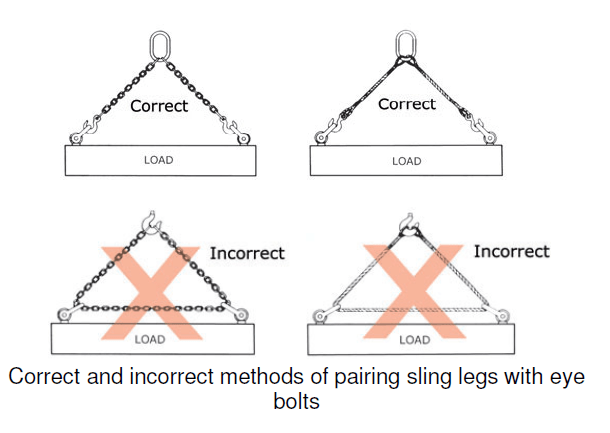
Eyebolt Working Load Limit (WLL) Chart
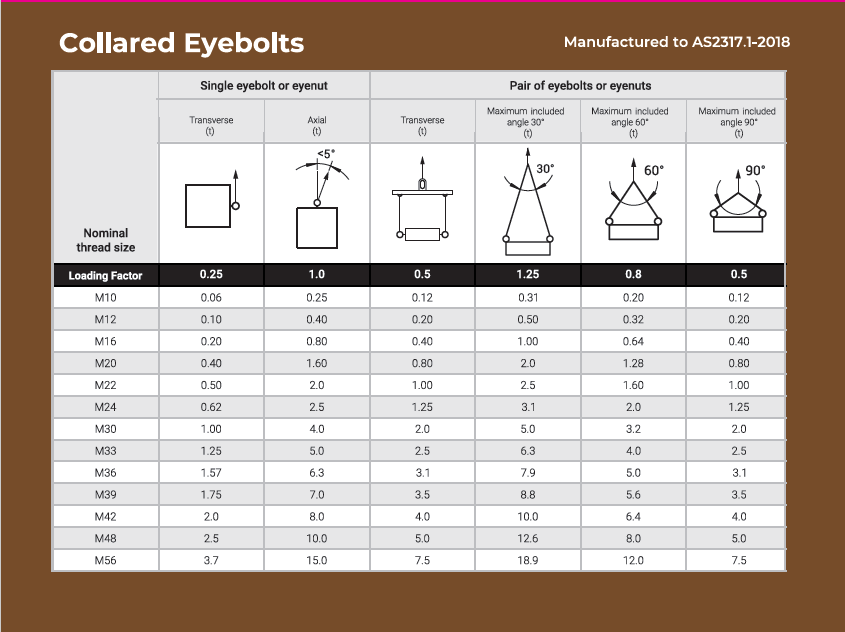

Contact Us
(07) 3205 7000
admin@absolutels.com.au
